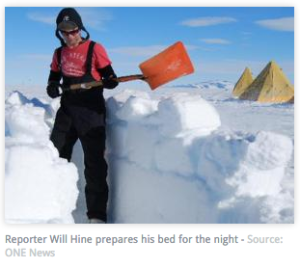Every summer, a handful of journalists descend on Scott Base in Antarctica joining the scientists, military and civilian personnel travelling down there to keep New Zealand’s operations running and to carry out important scientific research.
 The media trips, sponsored by Antarctica New Zealand, have produced some great journalism over the years. But this year’s seasonal visit seemed to get higher than normal profile thanks to the work of TVNZ science reporter Will Hine and the prominence his news reports were given across TVNZ’s news programmes from Breakfast to One News.
The media trips, sponsored by Antarctica New Zealand, have produced some great journalism over the years. But this year’s seasonal visit seemed to get higher than normal profile thanks to the work of TVNZ science reporter Will Hine and the prominence his news reports were given across TVNZ’s news programmes from Breakfast to One News.
Several of Hine’s pieces focussed on science underway down there, from efforts to dart killer whales to obtain tissue samples to learn more about their diet, to Waikato University’s Professor Craig Cary’s use of aerial drones to undertake research in the Dry Valleys. The reports were really well put together, which is a credit to Hine and his camera operator Brent Walters, but also the scientists and logistical personnel who assisted the TVNZ team to shoot in challenging conditions.
“It was pretty full-on with long days but absolutely worth the effort,” Hine said of the trip.
Credit to TVNZ for giving the coverage a decent run over several weeks and to Antarctica New Zealand for continuing the programme, which helps put in context the wide range of science-related issues New Zealanders are exploring in Antarctica, the health of which is increasingly understood as being related to the broader state of our oceans, marine life and climate. A temporary shutdown of US Government programmes late last year threatened to impact on all science taking place in Antarctica. But it appears much of the research that was planned was able to be undertaken after all.
Another New Zealand Navy-hosted expedition including journalists such as TVNZ’s Renee Graham and Fairfax’s Michael Fox, is currently underway to the sub Antarctic islands, but has had to divert to Stewart Island due to bad weather and 14 metre high waves pounding the ship.
Graham told TVNZ: “The sounds were incredible. Like out of a movie. Booming and rumbling. The movements were incredibly violent.”
Which goes to show that heading to the deep south is no junket – but hard and often dangerous work for the journalists involved!
Links to Hine’s news reports and blog posts are available below.
Where Antarctica resembles Central Otago
The vastness of Antarctica floored me
Lonely summer for Antarctic researchers
Surviving the night outdoors in Antarctica
Aerial drones put to use by Antarctica scientists
Undertaking science in Antarctica is no picnic
NZ scientists fire darts at killer whales to research diet
Penguin chick numbers fall in Antarctica